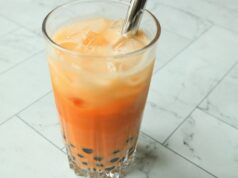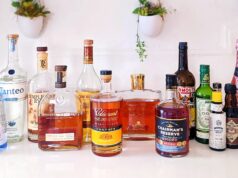

All great artists—from painters and poets to cellists and chefs—begin by studying the classics in their chosen field,” writes Alex Day in the introduction to Cocktail Codex, winner of the James Beard Foundation’s 2019 Book of the Year. Then they “emulate and practice those classics until they’ve developed their own signature style and can create original works.”
Day, one of the owners of Death & Co. among other impressive hospitality credentials, is of course applying the principle to bartenders, but anyone can become a masterful mixologist by following the same tack. All that is required to begin with is plenty of time—which most of us have at the moment—and a properly equipped home bar.

According to a survey conducted by Bacardi Limited, over the holidays just past, one in four Americans were planning on making cocktails at home while 53% of respondents planned to drink more cocktails over the festive season in general. With service at bars necessarily limited and online spirits sales skyrocketing, it’s safe to say most of them will be breaking out their shakers and coupes. So how to become truly proficient in the art of mixing drinks?

“For many people, the first strategy in studying cocktails is to memorize a bunch of recipes,” Day writes. “However, it’s a well-known (but rarely acknowledged) secret among bartenders that almost every cocktail in existence today can be traced back to a handful of seminal drinks.”
Master these essential imbibables and you are well on your way to earning those mixology credentials. Many classic cocktails can be “organized into ‘families,’ or groups of drinks cut from the same cloth.” Day notes.

“This allows us to grasp a handful of recipes that connect to many more due to their similarities.” A better way to think about them is as “intuitive progressions arising from a handful of well-known templates: the Old-Fashioned, Martini, Daiquiri, Sidecar, Highball, and Flip.”
Day advises that it is important to both study the classics and understand the scientific reasons behind what makes an iconic cocktail. “After you have mastered the classics and have an understanding of the physical (cocktail) universe, you can apply that knowledge” and create your own drinks with confidence and élan.

It is the same principle that the world’s best-dressed men have always applied to style: you must first know the rules inside out in order to break them.
While this may seem like something professional bartenders learn by rote, applying such an approach in your own domicile can be more difficult—even for the aforementioned pros, as Tristan Stephenson, the mastermind behind some of London’s most avant-garde cocktail bars, writes in his book The Curious Bartender: Cocktails at Home: More than 75 Recipes for Classic and Iconic Drinks, due out in April from Ryland Peters & Small (and currently available for pre-order on Amazon).

“A professional bar station and a domestic kitchen have very little in common with one another,” he notes. “Asking a top bartender to make world-class drinks at home is no easier than expecting a Michelin star chef to produce a tasting menu from scratch in a domestic kitchen. It’s not impossible but it requires a transfer of skill to a different environment, using and sometimes substituting equipment, and doing all of it in what is generally a far more confined space…. For a professional bartender it can be a difficult transition to make.”

The key, whether amateur or seasoned drink-slinger, after one has acquired a thorough knowledge of classic cocktails, is to master the techniques required to prepare them, and to ensure you have the proper equipment and ingredients on hand, Stephenson points out. And beyond proper ingredients, we’d add, the best ingredients are an even better approach.
Can’t find exactly what you need? Consider using a high-end cocktail base, like Proof Cocktail Syrup, which comes in several varieties and makes 32 drinks per bottle. As Brooks Cloud, Proof’s Founder and CEO puts it, “Proof is for people who have high standards and not a lot of time. We wanted to make mixing classic cocktails easy and fast, without sacrificing quality or authenticity.”

Regarding spirits, Stephenson points out that, “It’s a common understanding that a cocktail is only as strong as its weakest link, but in reality not all links in the chain are of equal size. If you’re making a Martini, the gin is an important consideration as it is at the forefront of the flavor profile, so a little more care in selection is required. In a cocktail such as the Negroni where the gin battles against far more powerful flavors than that of the dry vermouth in the Martini, there is clearly less need to be fastidious about the brand of gin,” though he advises against citrus-forward gins.

Stephenson again draws a comparison with the art of cooking: “If you’re making spaghetti bolognese, the exact cut of ground beef is not as important as the tomatoes, cooking time, quality of the pasta etc. If you’re frying a steak, however, the cut of beef becomes a very important factor.” He recommends selecting a single brand from each of the main spirit categories—gin, vodka, whisky, rum, tequila, and cognac—and making it your go-to for mixing drinks. “This practice will save you a lot of space and expense and ensure that your spirit cupboard doesn’t contain a bunch of dusty neglected bottles,” he posits.

Following this advice, you need only purchase six bottles of spirit to begin your adventures in mixology, which will stand you in good stead even after you’ve graduated beyond Alex Day’s six essential drinks. “My main piece of advice is that you make sure you pick ones that are versatile, of a premium quality and pleasing to drink neat,” Stephenson counsels. After all, if you wouldn’t want to drink it straight up, why use it in a cocktail?

So which brands does Stephenson, with his years of expertise and experience, recommend—and which cocktails show them off to best advantage? Among his favorites are Tanqueray gin, Woodford Reserve bourbon, Dewar’s 12 Year Old Scotch, Pierre Ferrand cognac, Belvedere vodka, and Don Julio tequila.
On the cocktail front, Tanqueray shines in drinks like the Aviation, which dates back to 1916 and sees the iconic spirit blended with fresh lemon juice, maraschino liqueur, and creme de violette; and the Ramos Gin Fizz, a New Orleans classic which must be shaken for at least 12 minutes. Woodford Reserve makes the ideal Manhattan, accompanied by vermouth (Martini Rosso works perfectly) and orange bitters.

Dewar’s excels in the Blue Blazer, a fantastic flaming concoction attributed to Jerry Thomas, the father of American mixology; the Rusty Nail, wherein it is combined with Drambuie, a connoisseur-favorite whisky liqueur; and the Whisky Mac, a charming stalwart from Scotland in which the whisky is mixed with Stone’s Original Ginger Wine. This is harder to come by in the U.S. than the UK, but well worth the effort, as Stephenson calls it the “corduroy jacket” of the drinks world—beloved of the innately stylish and immune to fashion.
If tequila is your tipple of choice, try the Paloma, made with fresh lime juice and grapefruit soda, which most people in Mexico prefer to the Margarita; or the always-popular Tequila Sunrise, with orange juice and grenadine.

Rum runners can seek solace in the depths of a Daiquiri, a Dark ’N Stormy, or the famous and flammable mid-17th century Flip, in which it is mixed with dark ale, sugar and molasses, and heated with a red-hot poker; while vodka lovers can find contentment in a Bloody Mary, Espresso Martini, or our personal favorite, the Moscow Mule, which combines the clear spirit with fresh lime juice, simple syrup and ginger beer, and can only properly be served in a copper mug.
And as always, repeat as necessary.








